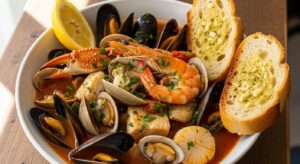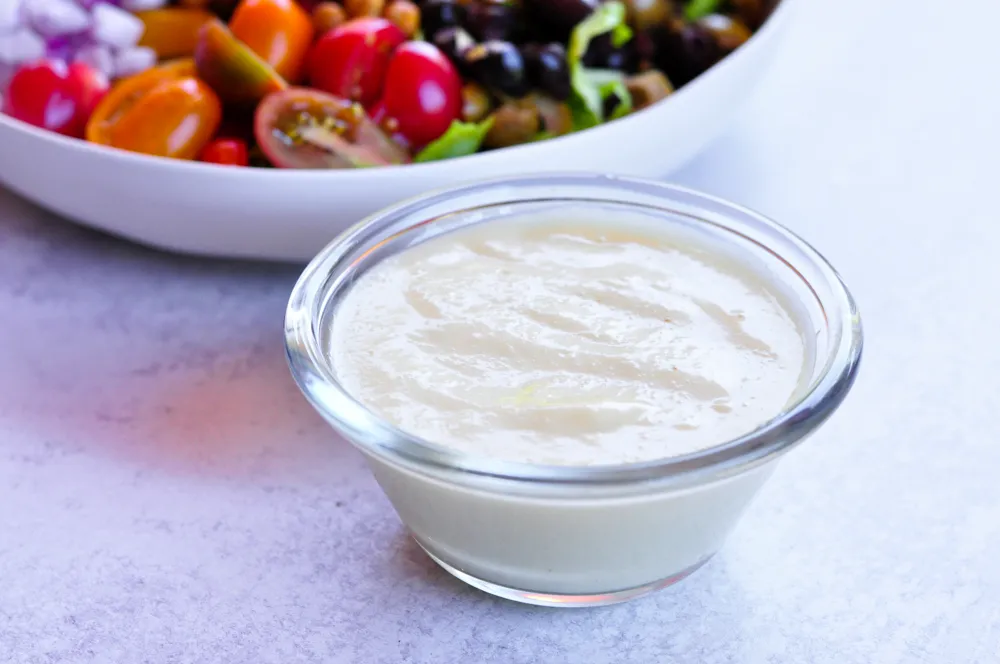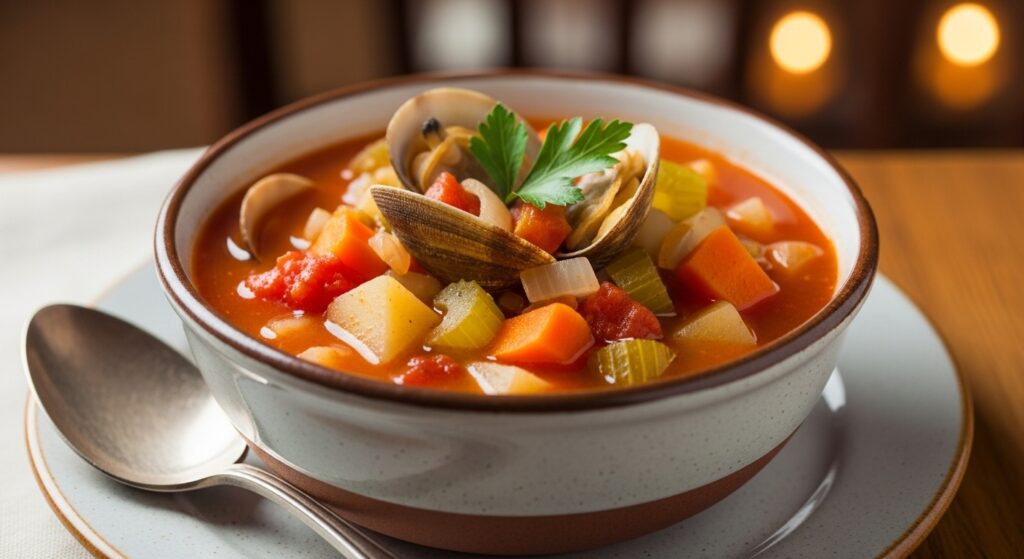If you love rich, tomato-based seafood stews, you’re in for a treat! Cioppino is an Italian-American dish that originated in San Francisco, crafted by Italian fishermen in the late 1800s.
Traditionally made with the day’s catch, this hearty stew features a mix of shellfish, white fish, and aromatic vegetables simmered in a savory tomato and wine broth.
The beauty of cioppino is that it’s incredibly flexible — you can use whatever fresh seafood you have available.
Also Check: Simple baked beans recipe
It’s perfect for special occasions, dinner parties, or simply when you want to enjoy a restaurant-quality meal at home.
This article includes affiliate links. If you make a purchase through these links, I may earn a commission at no extra cost to you. Your support is highly appreciated.
Ingredients You’ll Need
(Serves 4–6)
-
¼ cup olive oil
-
1 large onion, finely chopped
-
2 shallots, minced
-
4 cloves garlic, minced
-
1 large fennel bulb, thinly sliced
-
1 red bell pepper, diced
-
1 (28 oz) can crushed tomatoes
-
1 (8 oz) can tomato sauce
-
1½ cups dry white wine
-
4 cups seafood stock (or fish stock)
-
1 tsp dried oregano
-
1 tsp dried basil
-
1 tsp red pepper flakes (optional for heat)
-
Salt and black pepper, to taste
-
1 lb mussels, cleaned and debearded
-
1 lb clams, scrubbed
-
1 lb large shrimp, peeled and deveined
-
1 lb firm white fish (halibut, cod, or sea bass), cut into chunks
-
½ lb scallops
-
Fresh parsley, chopped, for garnish
-
Crusty bread for serving
Step-by-Step Instructions

1. Sauté the Aromatics
Heat olive oil in a large enameled cast iron Dutch oven (like the Lodge 6-Quart Enameled Dutch Oven) over medium heat.
Add onion, shallots, fennel, and bell pepper. Cook for about 6–8 minutes until softened. Add garlic and cook for another minute, being careful not to burn it.
2. Build the Flavor Base
Stir in the crushed tomatoes and tomato sauce. Add the wine, seafood stock, oregano, basil, and red pepper flakes.
Season with salt and pepper. Bring the mixture to a simmer, cover partially, and cook for 25–30 minutes to let the flavors meld.
3. Add the Seafood in Stages
Since different seafood cooks at different rates, add them in stages:
-
Add the clams and mussels first, cover, and cook for about 5 minutes until they begin to open.
-
Add the shrimp, fish, and scallops next. Simmer for another 5 minutes, or until the shrimp turn pink and the fish is opaque.
(Tip: Use a seafood steaming pot like the Concord Stainless Steel Steamer if you prefer steaming shellfish separately before adding them.)
4. Discard Unopened Shellfish
Any mussels or clams that remain tightly closed after cooking should be discarded, as they may not be safe to eat.
5. Serve and Enjoy
Ladle the cioppino into large bowls, sprinkle with fresh parsley, and serve with warm, crusty bread for dipping. A bread warming basket (like this woven bread warmer on Amazon) keeps your bread toasty throughout the meal.
Tips for the Best Cioppino
-
Use the freshest seafood you can find — it makes a world of difference.
-
Don’t overcook the seafood; it should be tender, not rubbery.
-
Customize your mix — add crab legs, lobster tails, or squid for variety.
-
Make the broth ahead — you can prepare the tomato-wine base a day in advance and add the seafood just before serving.
Perfect Pairings
Cioppino pairs beautifully with:
-
Garlic bread or sourdough for soaking up the broth.
-
A crisp white wine like Sauvignon Blanc or Pinot Grigio.
-
A fresh green salad for balance.
Common Mistakes to Avoid When Making Cioppino
1. Overcooking the seafood
Seafood cooks fast, and overcooking can make it rubbery. Add different types of seafood in stages based on how long they take to cook.
2. Using low-quality or old seafood
Fresh seafood makes all the difference in flavor. If you must use frozen, thaw it completely and pat it dry before adding it to the stew. A seafood prep board can help keep things clean and organized.
3. Skipping the sauté step
Don’t rush the start — sautéing onions, garlic, fennel, and peppers builds the base flavor for the stew.
4. Adding all the liquid at once
Pour in liquids gradually so you can control the thickness and taste. If it’s too thin, simmer uncovered for a bit to let it reduce.
5. Forgetting to discard unopened shellfish
If clams or mussels don’t open after cooking, throw them out. They may not be safe to eat.
Frequently Asked Questions (FAQs) About Cioppino Recipe
1. Where did cioppino come from?
Cioppino started in San Francisco in the late 1800s. Italian fishermen made it with whatever seafood they caught that day, mixed with tomatoes, wine, and herbs. The name comes from an Italian word meaning “chopped.”
2. Can I make cioppino without wine?
Yes! You can swap the wine for seafood or chicken broth. If you still want that slight tang, add a little lemon juice or white wine vinegar at the end. If you do use wine, a Vintorio Wine Aerator Pourer makes it taste even better.
3. What seafood is best for cioppino?
Popular choices include mussels, clams, shrimp, scallops, and firm white fish like halibut or cod. You can also add crab, lobster, or squid. For shellfish, a Concord Stainless Steel Steamer works great.
4. How do I keep seafood from overcooking?
Add seafood in stages — clams and mussels first, then shrimp, scallops, and fish near the end. Keep the stew at a gentle simmer, not a boil. A ThermoPro Digital Thermometer helps make sure fish is cooked just right.
5. Can I make cioppino ahead of time?
Yes, but only make the broth ahead. Store it in the fridge, then reheat and add the seafood right before serving. This keeps the seafood tender and fresh-tasting.
Final Thoughts
This cioppino recipe is a show-stopping seafood stew that’s surprisingly easy to make at home.
With a flavorful tomato base and a medley of fresh seafood, it’s a dish that turns any dinner into a celebration.
Equip your kitchen with quality cookware, and you’ll be serving up restaurant-worthy cioppino in no time.





